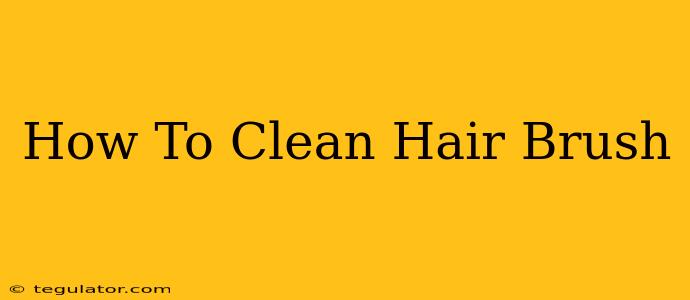Maintaining a clean hairbrush is crucial for both the health of your hair and scalp. A buildup of dirt, hair product residue, dead skin cells, and even bacteria can lead to clogged follicles, irritated scalp, and dull, lifeless hair. This comprehensive guide will walk you through various methods for effectively cleaning your hairbrush, ensuring it remains a tool that enhances, rather than hinders, your hair care routine.
Why Cleaning Your Hairbrush Matters
You might not think about it often, but your hairbrush collects a lot more than just loose strands. Regular cleaning prevents the following issues:
- Clogged follicles: Buildup can block hair follicles, leading to potential hair loss or slower hair growth.
- Scalp irritation: Residue and bacteria can irritate your scalp, causing itching, dandruff, and other scalp conditions.
- Dull hair: Product buildup weighs down your hair, leaving it looking dull and lifeless.
- Spread of bacteria and germs: A dirty brush can transfer bacteria and germs back to your scalp and hair, potentially leading to infections.
- Reduced brush effectiveness: A clogged brush simply doesn't work as well, failing to detangle and style your hair properly.
How to Clean Your Hair Brush: Step-by-Step Guide
The best cleaning method depends on your brush type (paddle brush, round brush, detangling brush, etc.). However, the general principles remain the same. Here's a thorough cleaning guide:
1. The Initial Removal:
- Remove loose hair: Use a comb or your fingers to remove as much loose hair as possible from the brush. For brushes with densely packed bristles, you can use a tool specifically designed for this purpose (many are available online or at beauty supply stores). Some prefer to use tweezers for smaller brushes.
2. Cleaning Methods:
- For Plastic and Wooden Brushes:
- Soapy Water: Mix warm water with a gentle shampoo or dish soap. Submerge the brush bristles in the soapy water, gently agitating them to loosen any remaining dirt and product buildup. Rinse thoroughly under running water, ensuring all soap residue is removed. Allow it to air dry completely, bristles facing down.
- Baking Soda Paste: For stubborn grime, create a paste of baking soda and water. Apply it to the bristles, gently scrubbing with an old toothbrush. Rinse thoroughly and air dry.
- For Brushes with Natural Bristles (e.g., boar bristle brushes):
- Gentle Cleaning: Avoid submerging natural bristle brushes in water, as this can damage the bristles. Instead, use a damp cloth with mild soap to wipe the bristles clean, followed by a thorough rinsing with a damp cloth. Air dry completely.
3. Deep Cleaning:
For a truly deep clean, consider these steps every few months:
- Vinegar Soak (for Plastic and Wooden Brushes ONLY): Soak your brush in a mixture of equal parts water and white vinegar for about 30 minutes. This helps dissolve buildup and disinfect the brush. Rinse thoroughly and air dry.
- Disinfecting (Optional): After cleaning, consider using a disinfecting spray (alcohol-based wipes work well, too). Allow it to air dry.
4. Drying:
- Air Dry: Always allow your hairbrush to air dry completely before using it again. This prevents the growth of mold and mildew. Lay it flat with the bristles facing down.
Maintaining a Clean Hairbrush: Tips and Tricks
- Regular Cleaning: Aim to clean your hairbrush at least once a week, or more frequently if you use a lot of hair products.
- Different Brushes for Different Purposes: Consider having separate brushes for styling and detangling to minimize the transfer of products and dirt.
- Gentle Handling: Avoid rough handling that can damage the bristles or break the brush.
By following these steps, you can ensure your hairbrush remains clean and effective, contributing to healthy, shiny, and beautiful hair. Remember, a clean brush is a happy brush (and a happy scalp!).

